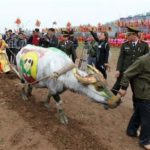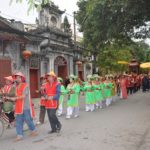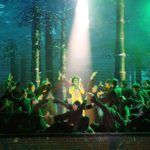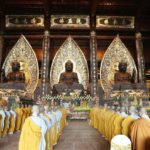The crowd erupted with deafening cheers, accompanied by joyous music and an awe-inspiring display of fireworks that seemed to recreate the battle of the gods. The celebration was a truly remarkable sight to behold.
This year’s Lang Pagoda Festival, held at Lang Pagoda in Lang Thuong Ward, Dong Da District, Hanoi, on April 26th, was a highlight for thousands of attendees. From traditional activities such as incense offering to colorful performances, the festival was an unforgettable experience for all who attended. Many visitors came to the pagoda to enjoy the celebration, take part in the activities, and make offerings to the Buddha. With an array of traditional and modern activities, the festival was a vibrant and joyful experience that left a lasting impression on everyone who participated.
| Middle-aged women dance in the procession. Photo: Minh An/The Hanoi Times |
Lang Pagoda (Chieu Thien Tu) was officially declared a National Historical Cultural Relic by the State in 1962. One of the 12 most famous relics and landscapes of Hanoi, it was listed as one of the first iconic cultural sites of the nation. This ancient pagoda boasts a history of nearly 500 years and is a representation of the city’s rich cultural heritage. It is a popular tourist attraction, offering visitors an opportunity to explore its unique architecture, detailed sculptures, and ancient artifacts.
The majestic Tien Duong (Front Chamber) of the pagoda is a complex of architectural structures, comprising of Outer Triple Arch Gates and Inner Triple Arch Gates, a courtyard, an octagonal house, and two parallel residences. It is surrounded by old trees, lending a tranquil and solemn atmosphere to the area. Inside the chamber stands Phuong Dinh (Pavilion), Trung Duong (Middle Chamber), Thieu Huong (Incense Burner) and Thuong Dien (Upper Chamber). These structures together make up the main features of the pagoda, providing a unique and unforgettable experience to visitors.
On either side of the upper chamber of the pagoda are two corridors filled with statues, cult objects, 12 ordinations of kings of the Le, Tay Son and Nguyen dynasties, and 15 stone steles with sculptural styles of the Le and Nguyen dynasties. Behind the houses of the big bell and chime lies the worship area for the mother goddesses and the ancestors, while the tower garden is located at the back of the pagoda. Nearly 200 artifacts have been preserved in pristine condition.
The Pagoda of King Ly Anh Tong was built in 1175 to honor his father, King Ly Than Tong, and the renowned Zen Master Tu Dao Hanh, a revered monk in the history of Vietnamese Buddhism. Built during King Ly Anh Tong’s reign (1136–1175), the pagoda was dedicated to the worship of the Buddha. It stands as a reminder of the king’s admiration for his father and the great monk, Tu Dao Hanh.
| Drummers prepare for the procession. Photo: Minh An/The Hanoi Times |
On the festive occasion, along with performing traditional rituals, local people proudly carry a palanquin in a celebratory procession from Lang Pagoda to nearby villages. This procession is a time-honored tradition that marks the joy and unity of the area’s community.
The festival’s highlight is a spectacular firework display that recreates the legendary battle between Tu Dao Hanh and his enemy in a bid to avenge his father. Witness this awe-inspiring show, and marvel at the amazing display of colours as the story of Tu Dao Hanh unfolds in the night sky.
With these values, the Lang Pagoda Festival was recognized as a national intangible cultural heritage by the Ministry of Culture, Sports and Tourism in 2019. The festival takes place every year, but the traditional ritual celebration has been interrupted for some time for many reasons.
| The festival attracts thousands of people. Photo: Ngo Minh/The Hanoi Times |
For the first time in 70 years, the Lang Pagoda Festival is reviving all the traditional rituals that made the Spring Festival in the Lang region one-of-a-kind. The revival is intended to safeguard and promote the national intangible cultural heritage of the Lang Pagoda Festival and also fulfill the religious needs of the locals and visitors alike, according to Pham Thi Hong Hai, Chairwoman of Lang Thuong Ward People’s Committee.
On the occasion, nine mango trees and three longan trees in the Lang Pagoda garden were recognized as Vietnam Heritage Trees.











